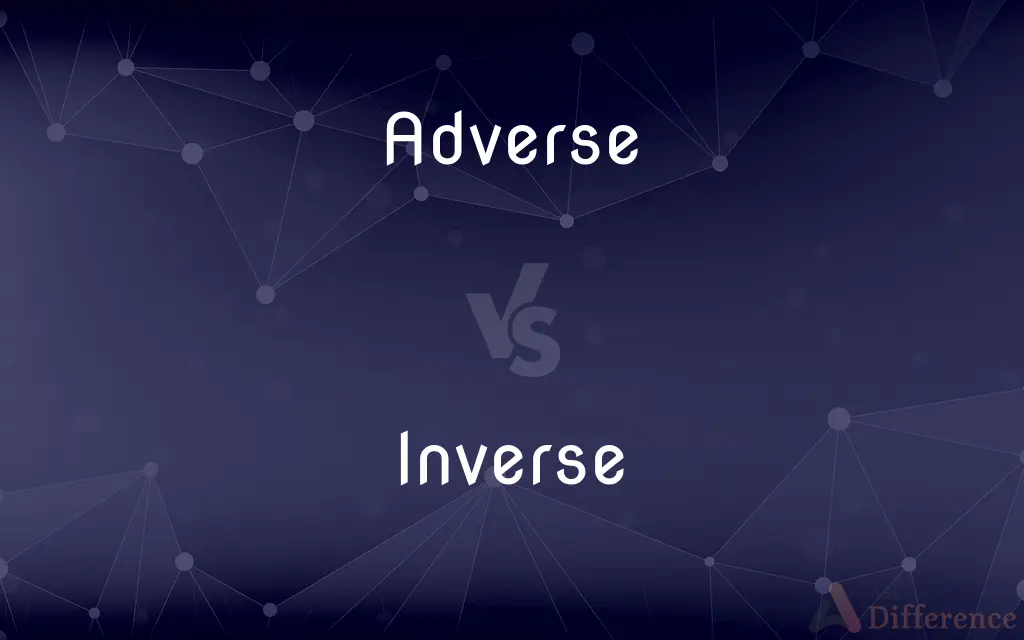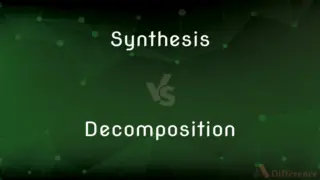Adverse vs. Inverse — What's the Difference?
By Tayyaba Rehman & Fiza Rafique — Updated on May 3, 2024
Adverse refers to unfavorable or harmful conditions, while inverse indicates a relationship where one variable increases as another decreases.

Difference Between Adverse and Inverse
Table of Contents
ADVERTISEMENT
Key Differences
Adverse is typically used to describe conditions or situations that are unfavorable, harmful, or detrimental to one's interests. Whereas, inverse describes a mathematical or relational condition where one value decreases as another increases, such as in an inverse relationship.
In practical terms, encountering adverse weather can negatively impact travel plans or agriculture, implying a direct harm or challenge. On the other hand, an inverse relationship in economics might mean that as supply increases, prices decrease, without implying harm but indicating a proportional relationship.
Adverse effects or reactions, often used in the context of medicine, indicate harmful outcomes from medications or treatments. Conversely, an inverse function in mathematics reverses another function, highlighting a relationship of reversal rather than harm.
The use of adverse is generally linked to scenarios involving risk, obstacles, or negative outcomes, such as adverse market conditions that hinder business growth. In contrast, discussing an inverse scenario in science might refer to processes or theories where elements operate in opposition.
While adverse has a clearly negative connotation, implying something directly detrimental, inverse is neutral and used to describe opposite or reversed conditions in various scientific, mathematical, and general contexts.
ADVERTISEMENT
Comparison Chart
Definition
Describes conditions or effects that are unfavorable or harmful.
Describes a relationship where one variable increases as another decreases.
Contexts Used
Medicine, law, weather, general risk scenarios.
Mathematics, physics, general relational contexts.
Connotation
Negative, indicating something harmful or detrimental.
Neutral, indicating a mathematical or relational reversal.
Examples
Adverse weather conditions, adverse reactions to drugs.
Inverse relationship between demand and price, inverse functions in math.
Implication
Indicates direct harm or negative impact.
Indicates a reverse or reciprocal relationship without inherent harm.
Compare with Definitions
Adverse
Preventing success or development; harmful; unfavorable.
Adverse weather conditions caused the cancellation of the outdoor event.
Inverse
Used to describe situations where elements are reversed in position or order.
Inverse order of events can sometimes confuse the narrative.
Adverse
Characterized by antagonism or hostility.
The team encountered adverse competitors who played aggressively.
Inverse
Opposite or contrary in position, direction, order, or effect.
There is an inverse relationship between the quantity of a product and its price.
Adverse
Unfavorable or harmful.
The adverse effects of the medication were severe and led to further health complications.
Inverse
Reflecting a direct but opposite response or correlation.
As interest rates go up, the bond prices go down, an example of an inverse correlation.
Adverse
Acting against or in a contrary direction; hostile.
He faced adverse criticism during the presentation.
Inverse
In physics, describing a relationship where increases in one variable lead to decreases in another.
Inverse square law states that intensity of light or sound waves decreases as the distance from the source increases.
Adverse
In opposition to one's interests; harmful or unfavorable.
The new regulation had an adverse impact on small businesses.
Inverse
Mathematically, one element reverses the effect of another, especially through a reciprocal mathematical relationship.
The inverse function of multiplication is division.
Adverse
Adverse or adverse interest, in law, is anything that functions contrary to a party's interest. This word should not be confused with averse.
Inverse
Reversed in order, nature, or effect.
Adverse
Preventing success or development; harmful; unfavourable
Taxes are having an adverse effect on production
Adverse weather conditions
Inverse
(Mathematics) Of or relating to an inverse or an inverse function.
Adverse
Acting or serving to oppose; antagonistic
Adverse criticism.
Inverse
(Archaic) Turned upside down; inverted.
Adverse
Contrary to one's interests or welfare; harmful or unfavorable
Adverse circumstances.
Inverse
Something that is opposite, as in sequence or character; the reverse.
Adverse
Moving in an opposite or opposing direction
Adverse currents.
Inverse
The reciprocal of a designated quantity. Also called multiplicative inverse.
Adverse
Unfavorable; antagonistic in purpose or effect; hostile; actively opposing one's interests or wishes; contrary to one's welfare; acting against; working in an opposing direction.
Adverse criticism
Adverse weather
Inverse
The negative of a designated quantity. Also called additive inverse.
Adverse
Opposed; contrary; opposing one's interests or desire.
Adverse circumstances
Inverse
Opposite in effect, nature or order.
Adverse
(not comparable) Opposite; confronting.
The adverse page
The adverse party
Inverse
Reverse, opposite in order.
Adverse
Acting against, or in a contrary direction; opposed; contrary; opposite; conflicting; as, adverse winds; an adverse party; a spirit adverse to distinctions of caste.
Inverse
(botany) Inverted; having a position or mode of attachment the reverse of that which is usual.
Adverse
Opposite.
Inverse
(mathematics) Having the properties of an inverse; said with reference to any two operations, which, when both are performed in succession upon any quantity, reproduce that quantity.
Multiplication is the inverse operation to division.
Adverse
In hostile opposition to; unfavorable; unpropitious; contrary to one's wishes; unfortunate; calamitous; afflictive; hurtful; as, adverse fates, adverse circumstances, things adverse.
Happy were it for us all if we bore prosperity as well and wisely as we endure an adverse fortune.
Inverse
(geometry) That has the property of being an inverse (the result of a circle inversion of a given point or geometrical figure); that is constructed by circle inversion. Category:en:Curves
A circle inversion maps a given generalized circle to its inverse generalized circle.
Adverse
To oppose; to resist.
Inverse
Whose every element has an inverse (morphism which is both a left inverse and a right inverse).
Adverse
Contrary to your interests or welfare;
Adverse circumstances
Made a place for themselves under the most untoward conditions
Inverse
An inverted state: a state in which something has been turned (properly) upside down or (loosely) inside out or backwards.
Cowgirl is the inverse of missionary.
321 is the inverse of 123.
Adverse
In an opposing direction;
Adverse currents
A contrary wind
Inverse
The result of an inversion, particularly:
Inverse
The reverse of any procedure or process.
Uninstalling is the inverse of installation.
Inverse
(mathematics) A ratio etc. in which the antecedents and consequents are switched.
The inverse of a:b is b:a.
Inverse
(geometry) The result of a circle inversion; the set of all such points; the curve described by such a set.
The inverse P‘ of a point P is the point on a ray from the center O through P such that OP × OP‘ = r² or the set of all such points.
Inverse
(logic) The non-truth-preserving proposition constructed by negating both the premise and conclusion of an initially given proposition.
"Anything that isn't a dog doesn't go to heaven" is the inverse of "All dogs go to heaven." More generally, is the inverse of and is equivalent to the converse proposition .
Inverse
(mathematics) A second element which negates a first; in a binary operation, the element for which the binary operation—when applied to both it and an initially given element—yields the operation's identity element, specifically:
Inverse
(addition) The negative of a given number.
The additive inverse of is , as , as is the additive identity element.
Inverse
(multiplication) One divided by a given number.
The multiplicative inverse of is , as , as the multiplicative identity element.
Inverse
(functions) A second function which, when combined with the initially given function, yields as its output any term inputted into the first function.
The compositional inverse of a function is , as , as is the identity function. That is, .
Inverse
(category theory) A morphism which is both a left inverse and a right inverse.
Inverse
(card games) The winning of the coup in a game of rouge et noir by a card of a color different from that first dealt; the area of the table reserved for bets upon such an outcome.
Inverse
A grammatical number marking that indicates the opposite grammatical number (or numbers) of the default number specification of noun class.
Inverse
(surveying) To compute the bearing and distance between two points.
Inverse
Opposite in order, relation, or effect; reversed; inverted; reciprocal; - opposed to direct.
Inverse
Inverted; having a position or mode of attachment the reverse of that which is usual.
Inverse
Opposite in nature and effect; - said with reference to any two operations, which, when both are performed in succession upon any quantity, reproduce that quantity; as, multiplication is the inverse operation to division. The symbol of an inverse operation is the symbol of the direct operation with -1 as an index. Thus sin-1 x means the arc or angle whose sine is x.
Inverse
That which is inverse.
Thus the course of human study is the inverse of the course of things in nature.
Inverse
Something inverted in sequence or character or effect;
When the direct approach failed he tried the inverse
Inverse
Reversed (turned backward) in order or nature or effect
Inverse
Opposite in nature or effect or relation to another quantity ;
A term is in inverse proportion to another term if it increases (or decreases) as the other decreases (or increases)
Common Curiosities
What is the primary difference between adverse and inverse?
Adverse implies harmful or unfavorable conditions, while inverse refers to a reversed or opposite relationship.
Is an adverse effect always negative?
Yes, adverse effects are inherently negative as they denote harmful outcomes.
How should one interpret adverse conditions in a forecast?
As suggesting potentially harmful or unfavorable weather that could impact safety and activities.
Can adverse and inverse be related in any context?
They might coexist in discussions about effects, but they describe different aspects; adverse is qualitative and harmful, inverse is quantitative and relational.
Can inverse relationships help in economic modeling?
Yes, they are crucial for predicting how changes in one economic factor might inversely affect another.
What does an inverse relationship imply in mathematics?
It suggests that one variable will increase as the other decreases, often through a reciprocal function.
Why is it important to understand adverse effects in medicine?
It helps in managing and mitigating risks associated with treatments or medications.
How does the concept of inverse relate to technology?
In technology, inverse processes might involve reversing operations, like decrypting data that was encrypted.
Are there any positive implications of adverse?
Generally, no; adverse usually describes negative scenarios, although overcoming such conditions might lead to positive outcomes like resilience.
What can be considered an adverse situation in sports?
Conditions like adverse weather or unfavorable rulings that negatively affect gameplay.
Can adverse conditions be mitigated?
Yes, with proper planning and precautions, the impact of adverse conditions can often be reduced.
Can the concept of inverse be applied in everyday life?
Yes, understanding inverse relationships can help in grasping scenarios where two related aspects move in opposite directions.
How does an inverse function operate in algebra?
It reverses the outputs of another function, effectively undoing its effect.
Is understanding inverse necessary for scientific studies?
Yes, it helps in understanding phenomena where variables exhibit opposite behaviors under specific conditions.
What role does context play in defining adverse and inverse?
Context defines whether the term refers to something harmful (adverse) or something that operates oppositely (inverse).
Share Your Discovery

Previous Comparison
Synthesis vs. Decomposition
Next Comparison
Interframe vs. IntraframeAuthor Spotlight
Written by
Tayyaba RehmanTayyaba Rehman is a distinguished writer, currently serving as a primary contributor to askdifference.com. As a researcher in semantics and etymology, Tayyaba's passion for the complexity of languages and their distinctions has found a perfect home on the platform. Tayyaba delves into the intricacies of language, distinguishing between commonly confused words and phrases, thereby providing clarity for readers worldwide.
Co-written by
Fiza RafiqueFiza Rafique is a skilled content writer at AskDifference.com, where she meticulously refines and enhances written pieces. Drawing from her vast editorial expertise, Fiza ensures clarity, accuracy, and precision in every article. Passionate about language, she continually seeks to elevate the quality of content for readers worldwide.
















































